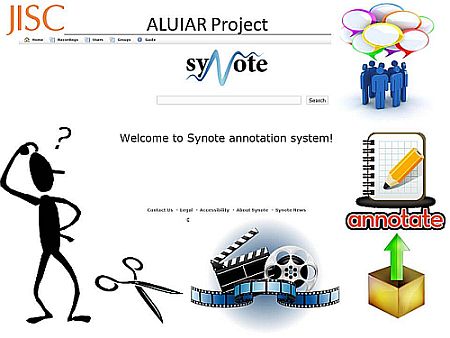 This project aims to improve the usability and learnability of the user interface of Synote, the open source web based video and audio annotation tool. There is the need support those researchers, non-specialist and novice users who wish to transcribe audio and video recordings with synchronised text.
This project aims to improve the usability and learnability of the user interface of Synote, the open source web based video and audio annotation tool. There is the need support those researchers, non-specialist and novice users who wish to transcribe audio and video recordings with synchronised text.
The key objective is to present users with an interface that is not only easy to use but is designed to suit the needs of researchers when uploading materials rather than the original users of Synote who tend to search and listen to lectures.
None of the main functionality of thee tool will be changed, but the way in which it will be used will be enhanced, so that it is more intuitive and logical to use. Existing users have already commented on some of the issues that need to be re-examined, such as navigation flexibility, interface learnability and the organisation of recordings and search features etc.
An ethnographic approach will be taken to benchmark Synote’s current performance. A small group of users will be interviewed and ‘walked through’ the tool whilst having their opinions, concerns and behaviour (whilst using the tool) monitored. These results will then be ranked and implemented to help identify the changes that should be made to Synote. These changes will be discussed again with the stakeholders and implemented using an agile interactive approach involving end users in regular co-design, and review meetings.
The success of interventions will be measured by the participants completing a questionnaire based on John Brookes System Usability Scale (SUS) and by quantifying the qualitative results gathered in interviews from the participants. It is felt that due to time constraints the number of interviews that take place before storyboarding interface designs will be minimal. Nielsen (2000) states that “the best results come from testing no more than 5 users and running as many small tests as you can afford.” The stated methods will provide quantitative and qualitative results that will inform the need to improve the adaptability, usability and learnability of Synote. Two other methods were considered but discarded due to the size of the project and time of year with many users going on holiday during July and August:
- Large Focus Groups – This would give a much richer pool of qualitative data, but as time is short this is an unrealistic data gathering method to undertake without going over schedule.
- Mass-questionnaire – These would give a greater pool of data, but work by Nielsen (2000) also showed that “the ultimate user experience is improved much more by three tests with 5 users than by a single test with 15 users.”
